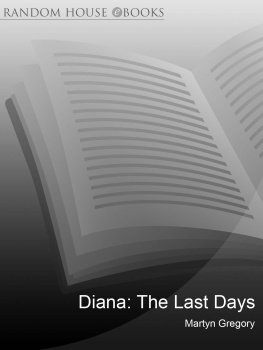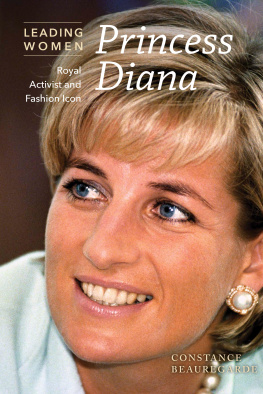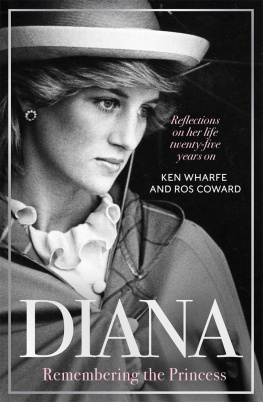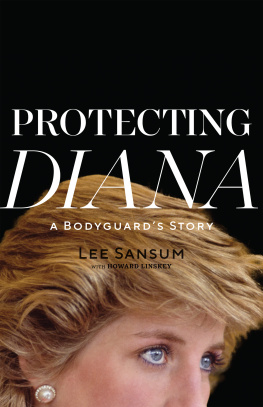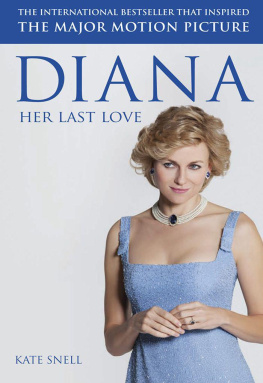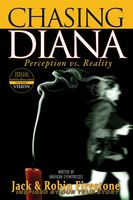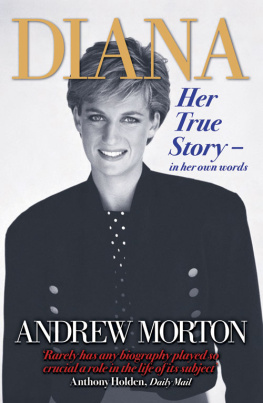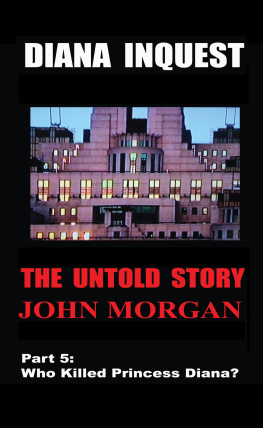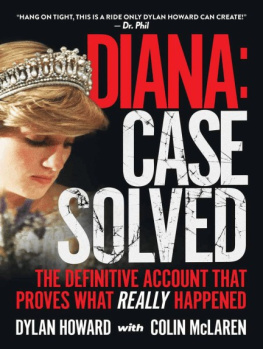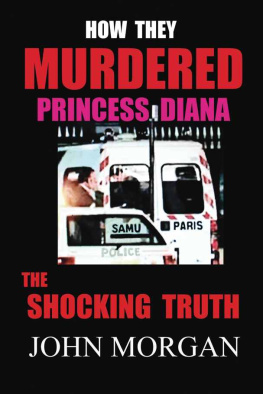DIANA
THE LAST DAYS
Martyn Gregory

This eBook is copyright material and must not be copied, reproduced, transferred, distributed, leased, licensed or publicly performed or used in any way except as specifically permitted in writing by the publishers, as allowed under the terms and conditions under which it was purchased or as strictly permitted by applicable copyright law. Any unauthorised distribution or use of this text may be a direct infringement of the authors and publishers rights and those responsible may be liable in law accordingly.
Epub ISBN: 9780753544310
Version 1.0
www.randomhouse.co.uk
This updated edition published in Great Britain in 2007 by
Virgin Books Ltd
Thames Wharf Studios
Rainville Road
London W6 9HA
First published in Great Britain in 1999 by
Virgin Publishing Ltd
Text copyright Martyn Gregory 1999, 2000, 2004, 2007
Translation of the Final Report by the Paris Prosecutors Office on the death of Diana, Princess of Wales Times Newspapers
Limited, 4 September 1999
The right of Martyn Gregory to be identified as the Author of
this Work has been asserted by him in accordance with the
Copyright, Designs and Patents Act, 1988.
This book is sold subject to the condition that it shall not, by way of trade or otherwise, be lent, resold, hired out or otherwise circulated without the publishers prior written consent in any form of binding or cover other than that in which it is published and without a similar condition, including this condition, being imposed upon the subsequent purchaser.
A catalogue record for this book is available from the British Library.
ISBN 978 0 7535 1162 6
The paper used in this book is a natural, recyclable product made from wood grown in sustainable forests. The manufacturing process conforms to the regulations of the country of origin.
Typeset by TW Typesetting, Plymouth, Devon
Printed in the UK by CPI Bookmarque, Croydon, CR0 4TD
1 3 5 7 9 10 8 6 4 2
To Paul Foot (19372004),
my friend and inspiration
AUTHORS NOTE
Some of the key witnesses to the events of 30/31 August in Paris have made important contributions to this book and, where appropriate, these have been acknowledged. Some witnesses have extracted money from the media for their stories; no witness quoted in this book has received any money at all from myself or my publisher.
In attempting to piece together Princess Dianas last days I have obtained information about statements made by some witnesses to Judge Stphans enquiry into the Alma tunnel crash that killed Diana, Princess of Wales. Frances severe legal and medical secrecy laws are designed to prevent this from being done. In practice, documents emerge unofficially, and many of them have informed this book. Readers can be sure that all factual references and quotations relating to the investigation are reliably sourced, but none can be acknowledged in my footnotes. I would like to thank those who have made this possible, and particularly those whom I am unable to identify.
Jean-Marie Pontaut and Jrme Dupuis excellent book Enqute sur la mort de Diana (ditions Stock, Paris, 1998) makes liberal use of statements made by witnesses to the events of 30/31 August in Paris, and extracts from their book are acknowledged in the footnotes. Death of a Princess was painstakingly, if very rapidly, researched by Time magazine journalists, Thomas Sancton and Scott MacLeod and was published less than six months after the crash. Their book, too, had good access to the early months of Stphans investigation, and some excellent French sources. I interpret events around the crash in a different way to the two Americans, but I would like to acknowledge the value of their books contribution to understanding how Fayed worked after the crash, and for its detailed study of the technical aspects of the crash itself.
Mohamed Fayed refused my requests to speak to him or any of his staff in Paris or in London. I am, therefore, particularly grateful to his past and present associates and employees who did speak to me. Their insights, and their information about what happened both before and after Princess Dianas death, have been invaluable. Where appropriate, their contributions are identified in the footnotes. Two of Fayeds key security personnel, Kez Wingfield and Ben Murrell, were both generous with the time they devoted to lengthy conversations with me. I am particularly grateful to them for helping me to understand what really happened during Princess Dianas last days in the Fayed familys care. Lawyers in France and Britain, who must remain anonymous, have given me valuable assistance with documents, guidance and insight.
I lent Tom Bower the interview files from my Dispatches investigation while he wrote his first-class, unauthorised biography of Mohamed Fayed which has already become the standard work on the Egyptian. I would like to thank him for his generous response in allowing me access to the invaluable notes he took of interviews he was permitted to conduct with Fayeds staff in Paris and London in the week after the crash.
Dr Murray Mackay, professor emeritus of Transport Safety at Birmingham University, is one of the worlds leading analysts of car crashes, and he helped me to interpret the findings of the French investigation. Professor Peter Vanezis, Regius professor of Forensic Medicine and Science at Glasgow University, was kind enough to discuss his analysis of the autopsy conducted on Henri Paul.
Some of Princess Dianas closest friends have helped me both off and on the record. The personal devastation they experienced when she died has only been exacerbated by the fantasists who have feasted on her memory. This motivated many of them to speak to me; I am deeply grateful to all of them. Any mistakes I might have made are entirely my own responsibility.
PREFACE
Like most people I know, I remember vividly where I was when I learnt the awful news that Princess Diana was dead. I woke at 04.00 on 31 August in a hotel room in the north of England. The television was on, showing 24-hour news I think I must have rolled on to the remote control in my sleep. The screen showed a static shot of the entrance to the Alma tunnel. The rear of a black Mercedes was visible in a scene that was bathed in an eerie orange light and the studio presenters voice informed me that Dodi Fayed is dead, and Princess Diana has been rushed to hospital... I watched in stunned dismay until the Princesss coffin emerged from the Piti Salptrire hospital many hours later.
From a personal point of view, the timing of the tragedy could not have been more hideously inappropriate. The previous day my brother, the Reverend Clive Gregory (who became the Bishop of Wolverhampton in 2007), had married Jenny Hyde in the village of Tetney. Some of our familys happiest moments had been celebrated that afternoon in the Lincolnshire wolds. On the morning that Princess Diana died, I made my way back to London with my other brother, Adrian, his wife Lisa and their baby daughter, Holly, listening in virtual silence to the blanket coverage of the tragedy on every radio station we tuned in to.
Princess Dianas life and death became the most ploughed furrow in world journalism in the months that followed the crash. I started my own investigation at the invitation of Channel 4s

